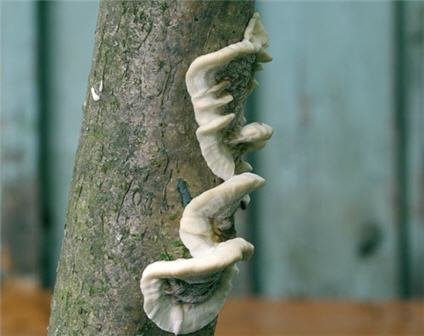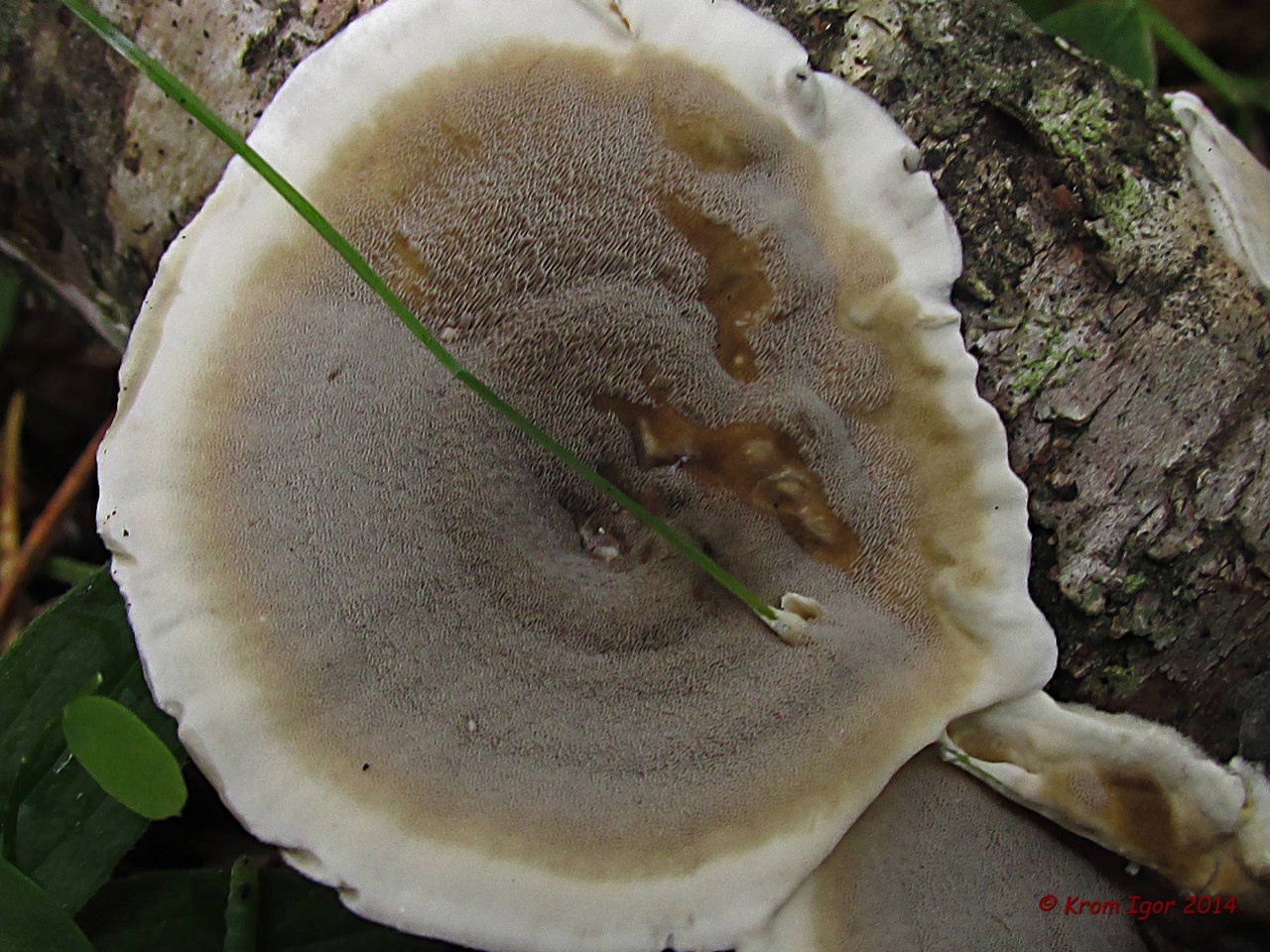Smoky polypore (Bjerkandera smoky, Bjerkanderafumosa) how it looks, where and how it grows,
Bjorkandera smoky (Smoky polypore): photo and description, impact on trees
| Name: | Smoky polypore |
| Latin name: | Bjerkandera fumosa |
| View: | Inedible |
| Synonyms: | Bjorkandera is smoky. |
| Specifications: | |
| Systematics: |
|
Smoky tinder fungus is a representative of tinder species, wood destroyers. It settles on the stumps of dead trees, almost immediately after that, the remnants of vegetation turn into dust. In various sources, you can find other names for it: bjerkandera smoky, Latin - Bjerkandera fumosa.
Description of the smoky tinder fungus
The hat grows up to 12 cm in circumference, up to 2 cm thick, its color is pale gray, while the edges are very light than the center. The surface is smooth or finely hairy.
The shape of the fungus is effusive-reflex, stretched over the substrate, in the form of a cap attached to the trunk, or extended, curved. The leg is missing.
There may be several mushroom caps on a tree, over time they grow together into one total mass
Ripe smoky polypores turn yellow. The edges of the cap are rounded, becoming sharper as they grow. The young representative of the species is friable, light gray, becomes compacted and brown with age.
A characteristic feature of a mature specimen: when cut on the fruiting body, a thin, dark line can be seen above the layer of tubules. The flesh of the mushroom is thinned, dark brown in color, spongy and tough.
With the arrival of the fruiting period, the bjorkander produces white, beige or colorless pores. They are located on the other side of the fruiting body, have a rounded, spherical shape, over time they become angular. On 1 mm of the surface of the fungus, from 2 to 5 smooth, very small spores mature. Their powder is straw yellow.
Where and how it grows
A parasitic fungus grows on fallen forest and garden trees, decaying stumps of deciduous crops. For gardeners, the appearance of a bjorkandera is a signal of the unhealthy of a fruit-bearing tree. It is necessary to immediately take measures to destroy the parasite, since the entire area will soon undergo infection.
In spring, the fungus parasitizes living trees, without signs of wilting.
Fruiting begins in April and lasts until the end of autumn (November). The smoky polypore feeds on the decaying remains of wood. The parasitic fungus is widespread in the Northern Hemisphere, everywhere in Russia, not counting the southern regions.
How does smoky tinder fungus affect trees
Mycelium spores enter the bark of the tree through cracks and breaks. Bjorkander, settling on the bark, grows in the center of the trunk, destroying it inside, embodies it in dust. At its first appearance, measures are taken, very often cardinal - the tree is destroyed, since it is impossible to remove the mycelium under the bark. Also, all smoky stumps affected by spores are uprooted. It is impossible to allow the spread of bjorkandera: it produces new, young fruiting bodies in a short time.
Doubles and their differences
The tinder fungus of this species has an inedible twin - the scorched bjorkander. The mushroom is spread everywhere, not only in our country, but all over the world. Fruiting from May to November.
The contrasting color distinguishes this basidiomycete from the rest of the species.
The mushroom cap has a shape similar to smoky tinder fungus - semicircular, outstretched, but thicker flesh. The tubes are also very large and brownish.
The skin on the cap is velvety, finely hairy. The color of the singed bjorkander is darker than that of the tinder fungus, actually black or dark gray, the edges have a whitish edging.
The places and region of residence of the two species are similar.
Conclusion
Smoky polypore is a basidiomycete parasitizing on deciduous trees. Its occurrence provokes the development of white mold - a disease dangerous for horticultural crops. The fight against the fungus at the first sign of its appearance should begin without delay. The key method is the uprooting and removal of infected debris from the site.
Taxonomy
Scorched Bjorkandera was first described by Karl Ludwig Wildenow as a composite genus of tubular mushrooms. In 1879, the famous Finnish mycologist Peter Adolf Karsten described a new genus from him Bjerkandera, naming it after the Swedish naturalist Klas Bjorkander.
Synonyms edit code
- Boletus adustus Willd., 1787basionym
- Boletus carpineus Sowerby, 1799
- Boletus concentricus Schumach., 1803
- Boletus crispus Pers., 1799
- Boletus fuscoporus Planer, 1788
- Boletus isabellinus Schwein., 1822
- Boletus pelleporus Bull., 1791
- Boletus suberosus var. flabelliformis Batsch, 1789
- Coriolus alabamensis Murrill, 1907
- Daedalea fennica (P. Karst.) P. Karst., 1906
- Daedalea oudemansii var. fennica P. Karst., 1882
- Daedalea solubilis Velen., 1926
-
Gloeoporus adustus (Willd.) Pilát, 1937
- Gloeoporus adustus f. atropileus (Velen.) Pilát, 1937
- Gloeoporus adustus f. excavavatus (Velen.) Pilát, 1937
- Gloeoporus adustus f. solubilis (Velen.) Pilát, 1937
- Gloeoporus adustus f. tegumentosus (Velen.) Pilát, 1937
- Grifola adusta (Willd.) Zmitr. & Malysheva, 2006
-
Leptoporus adustus (Willd.) Quél., 1886
- Leptoporus adustus f. resupinatus Bourdot & Galzin, 1928
- Leptoporus adustus f. viridans Pilát, 1936
- Leptoporus adustus f. zonatulus Quél., 1886
-
Leptoporus albellus (Peck) Bourdot & L. Maire, 1920
Leptoporus albellus f. raduloides Pilát, 1932
- Leptoporus crispus (Pers.) Quél., 1886
- Leptoporus nigrellus Pat., 1903
- Microporus gloeoporoides (Speg.) Kuntze, 1898
- Microporus lindheimeri (Berk. & M.A. Curtis) Kuntze, 1898
-
Polyporus adustus (Willd.) Fr., 1821
- Polyporus adustus f. resupinatus Bres., 1922
- Polyporus adustus subsp. carpineus (Sowerby) Fr., 1874
- Polyporus adustus var. argenteus (Ehrenb.) Pers., 1825
- Polyporus adustus var. carpineus (Sowerby) Pers., 1825
- Polyporus adustus var. pelleporus (Bull.) Pers., 1825
- Polyporus amesii Lloyd, 1907
- Polyporus atropileus Velen., 1925
- Polyporus burtii Peck, 1897
- Polyporus carpineus (Sowerby) Fr., 1818
- Polyporus cinerascens Velen., 1922
-
Polyporus crispus (Pers.) Fr., 1821
Polyporus crispus f. resupinatus Bres., 1922
- Polyporus curreyanus Berk. ex Cooke, 1886
- Polyporus digitalis Berk., 1854
- Polyporus dissitus Berk. & Broome, 1875
- Polyporus excavatus Velen., 1922
- Polyporus fumosogriseus Cooke & Ellis, 1881
- Polyporus halesiae Berk. & M.A. Curtis, 1853
- Polyporus lindheimeri Berk. & M.A. Curtis, 1872
- Polyporus macowanii Kalchbr., 1881
- Polyporus macrosporus Britzelm., 1894
- Polyporus murinus Rostk., 1838
- Polyporus ochraceocinereus Britzelm., 1895
- Polyporus scanicus Fr., 1863
- Polyporus secernibilis Berk., 1847
- Polyporus subcinereus Berk., 1839
- Polyporus tegumentosus Velen., 1925
- Polystictus adustus (Willd.) Gillot & Lucand, 1890
- Polystictus alabamensis (Murrill) Sacc. & Trotter, 1912
- Polystictus carpineus (Sowerby) Konrad, 1923
- Polystictus gloeoporoides Speg., 1889
- Polystictus ochraceostuppeus Lloyd, 1916
- Polystictus puberulus Bres., 1920
- Poria argentea Ehrenb., 1818
- Poria carnosa Rostr. ex Sacc. & D. Sacc., 1905
- Poria curreyana (Berk.ex Cooke) G. Cunn., 1947
- Tyromyces adustus (Willd.) Pouzar, 1966
Medicinal properties of lacquered tinder fungus
Lacquered polypores are one of the most famous basidiomycetes that have been used by Asian peoples for medicinal purposes for more than 2 thousand years. Lacquered polypores are called "mushrooms of immortality." In traditional Chinese medicine, they are awarded the highest category in terms of exposure and absence of side effects. According to clinical studies, these mushrooms have the following properties:
• Antiviral;
• Anti-inflammatory;
• Antimicrobial;
• Antineoplastic;
• Immunomodulatory.
Lacquered polypores normalize the functioning of the body and improve health. Reish mushrooms contain terpenoids, which help the body to resist stress. These mushrooms enhance the immune response in cancer patients, as well as suppress the emerging pathological processes in autoimmune diseases. They successfully help in the treatment of cardiovascular diseases, stabilize blood pressure, cope with pulmonary diseases, such as asthma, bronchitis, and the like.

Other mushrooms of this genus
The honeycomb tinder has a cap with a diameter of 2-8 centimeters. Its shape can be different - from oval to round. The color of the cap is red-yellow, ocher-yellow, pale yellow, orange. The cap is covered with scales that are darker in comparison with the rest of the surface.
The stem is very short; some mushrooms do not have it at all. Its height most often does not exceed 10 millimeters. The leg is white with a smooth surface.
Cellular polypores grow on dead deciduous wood. They bear fruit from April to August. They settle mainly in small groups, but sometimes they meet singly. Cellular polypores are edible mushrooms, although they are quite tough.
Smoky polypore, he is also Bjorkandera smoky, is found on stumps, grows in forest dead wood. Most often it settles in rotten wood, giving preference to ash, willow and apple trees. These mushrooms feed on the decomposition of wood residues. Smoky polypores bear fruit from spring to autumn.
The tinder fungus's hat is thick, its thickness reaches 2 centimeters, and its diameter reaches 12 centimeters. The fruit body is yellowish, and the edges are lighter. As they age, they become brownish in color. Young specimens are highly friable.

Smoky tinder fungus is an inedible mushroom. Its appearance on the tree suggests that it is painful. A polypore that appears on one tree can infect all fruit trees in the garden, so gardeners immediately take measures to remove them.
Biological description
Fruit bodies are annual, without legs, often almost prostrate, with a small part raised above the substrate, but almost never completely prostrate, soft, flexible and thin, 1-4 × 2-7 cm. The upper surface of the bent cap is felt-fibrous, then often glabrous or rough, usually finely wrinkled, whitish to yellowish-grayish and brownish. The edge of the cap is usually darker, sharper, often slightly curved.
The hymenophore is tubular, thin, initially whitish, rapidly gray to smoky and almost black. The pores are angularly rounded, 5-7 per millimeter.
The hyphalous system is monomytic. Hyphae of various thicknesses, slightly branched, uncolored or grayish, intertwined in the pulp, parallel in the hymenophore. Basidia are four-spore, clavate. Spores are elliptical, uncolored, 4.5-6 × 2.5-3 microns.
Bjorkandera does not contain any poisonous substances and does not have an unpleasant taste, however, its tough fruiting bodies do not allow it to be considered an edible mushroom.
Similar views edit code
Singed Bjorkander is easily identified by the ash-gray to almost black color of the hymenophore and the creamy upper surface of the cap (if it is pronounced). The second species of the genus, Bjorkandera smoky, is distinguished by thicker, buffy-yellowish fruit bodies, the tubes are larger, do not turn black with age, but turn brown.























































